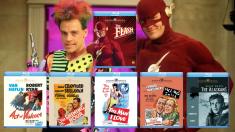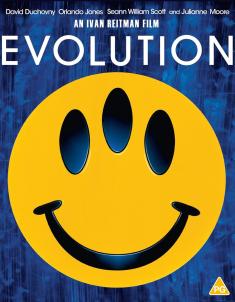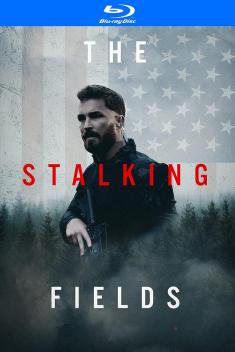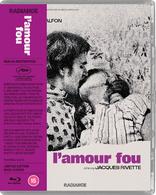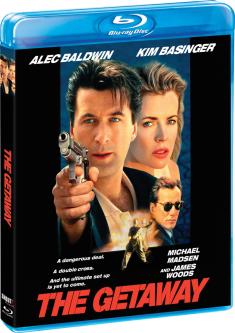Contact
Overview -Storyline: Our Reviewer's Take
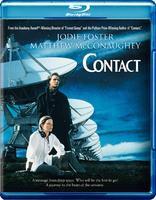
"I'm OK to go! I'm OK to go!"
I'm not sure how Robert Zemeckis really feels about it, but I like to think of 'Contact' as his apology for 'Forrest Gump'. What could he have to apologize for, you ask? 'Gump' is beloved by millions, made $850 billion at the box office, and won 73 Oscars, including the coveted Best Movie EverTM award. Surely that's a feather in any filmmaker's cap? Perhaps so, for those who have no scruples. Personally, I found the movie's reactionary political values and celebration of mindless, unquestioning ignorance as some sort of idealized way of life deeply appalling. Beyond its technical craftsmanship, the film bore little resemblance to any of the director's previous movies, most of which were intelligent entertainment. Whether there's any basis to it or not, it makes me feel better to believe that, on some level, Zemeckis must have experienced some degree of guilt watching his worst, most offensive movie become his most successful and celebrated. Maybe that's all in my head. I can live with that.
Where am I going with this? When Zemeckis announced that his next film would be an adaptation of Carl Sagan's famous science fiction novel about mankind's first contact with extraterrestrial life, I approached the project with deep skepticism. How could he screw this one up? The casting of Jodie Foster, an actress who generally knows how to pick a decent script, eased my fears a little. The trailers, which conveyed a mix of heady sci-fi concepts, big-budget visual effects, and nail-biting suspense, were fantastic. If not for the anomaly of 'Gump' in the director's career, this would have been my most anticipated movie of 1997. And yet, as I sat in the theater and waited for the lights to come down, my apprehension couldn't have been greater.
'Contact' grabbed me from the first shot – that first astounding, beautiful, mesmerizing shot that manages in three and a half uninterrupted minutes, with no actors or dialogue, solely through visual and aural sensation (or lack thereof), to place the entirety of mankind's existence on this planet into context against the unimaginable vastness of the universe. The packed theater house I was in collectively drew its breath in awe. If nothing else about the movie worked out, that shot alone was brilliant filmmaking. The rest of the picture had a lot to live up to. Somehow, it did.
'Contact' is the polar opposite of 'Forrest Gump' in every way. Following the lead of Sagan's book, the movie is a tribute to the passion and dedication of intelligent people driven in their pursuit of knowledge. Jodie Foster stars as Ellie Arroway, a research scientist for the SETI program who monitors radio signals from deep space in the hope of discovering some hidden pattern that might indicate intelligent life out there. Her work is dismissed as fruitless fantasy by a scientific community desperate to prove itself pragmatic and fiscally responsible to the public. Constantly at odds with a bureaucracy (embodied by Tom Skerritt as her assholish superior) that eventually refuses to fund her, Ellie seeks private backing from an eccentric billionaire (John Hurt). Even then, the government threatens to cut off her time leased on their radio telescope array, seemingly out of spite, to rid themselves of the embarrassment.
Just as all seems lost and her program stands on the verge of being dismantled, something happens. Something big. A signal. From space. Not naturally occurring. There's a pattern in it. Prime numbers. Mathematics. Intelligence.
Contact.
Events quickly escalate. The military tries to take over. Are little green men ready to invade the Earth? Panic. And yet, also excitement. Something out there has found us. Something profound. Ellie's team discovers a message in the signal. Schematics for some sort of machine. A big machine. What it is or does, no one can figure out, but there are detailed instructions to build it. Could it be a transport of some kind? If so, who will go?
In the midst of all this, Ellie fights to stake her claim in the discovery. Providing unexpected support is the New Age-y spiritual advisor to the White House, played by Matthew McConaughey (back when he was just emerging as a star, before he became an annoying parody of himself). Despite the author's atheistic views, the book and film respectfully acknowledge the belief that some things about the workings of the universe may be beyond our control. Science and faith, so often depicted in popular culture at odds with one another, are in fact different aspects of the same fundamental desire to understand our purpose in this world.
On a purely technical level, 'Contact' is a bravura piece of filmmaking. Zemeckis has put all of his experience with the 'Back to the Future' movies, 'Roger Rabbit', and yes even 'Gump' to good use in envisioning Sagan's story. Beyond the overt special effects set-pieces, almost every frame of the movie has some measure of largely-seamless CG enhancement, be it to change the color of an actor's eyes, adjust the position of an eyebrow, or stitch multiple shots together into single unbroken takes. The director's camera swoops directly through the closed glass of a window, and impossibly shifts perspective through a mirror in ways that almost defy comprehension. While sometimes showy for its own sake, the technique also effectively aids the storytelling.
While these little details are often impossible to detect, some of the big "effects" scenes have aged better than others. The workings of the Machine, a Harrier jet landing on an aircraft carrier, and a few other moments looks a little too animated. But frankly, not much more so than a lot of movies made today. I'd put anything in this film up against 'X-Men Origins: Wolverine', which was produced 12 years later for nearly twice the budget.
More likely to date the picture are the preponderance of CRT computer monitors, pagers, and a gimmicky attempt to integrate real clips of President Clinton into the action (in the same style used with the historical footage in 'Forrest Gump'). Also problematic is the syrupy score by Alan Silvestri that sounds like leftovers from 'Gump'. It grates on the nerves a little, but is thankfully used sparingly.
The film's climax also goes off the rails a bit. (It was later parodied mercilessly in an episode of 'South Park'.) The idea behind the final journey makes sense conceptually, but the execution is too trite and maudlin. Fortunately, Zemeckis manages to pull things together afterwards with a satisfying dénouement.
'Contact' may not be a perfect movie, but it's a smart, ambitious, and dramatically satisfying piece of speculative fiction that's still timely and relevant today. Despite its flaws, it's one of the best science fiction films of the last two decades.
The Blu-ray: Vital Disc Stats
'Contact' comes to Blu-ray from Warner Home Video. Like most of the studio's releases, the movie starts playback immediately without a main menu. At least they've finally figured out how to program their discs to default to the Dolby TrueHD audio track.
Video Review

Prior to this Blu-ray, it had been a while since 'Contact' was last remastered for home video. The film was an early DVD release for Warner, issued near the end of 1997. Subsequent DVD editions were merely reissues of the same disc in different packaging. Although good for its day, that DVD's video quality was certainly showing its age. The movie was due for a fresh transfer, which Warner has finally provided.
For the most part, the Blu-ray's 1080p/VC-1 transfer is extremely satisfying. The 2.40:1 picture is crisp and nicely detailed throughout. The faint presence of film grain appears properly resolved. Contrast and black levels are solid, which is especially important for a movie with such a focus on outer space. The image has a strong sense of texture and depth.
The one area that doesn't seem quite right is color saturation. Some misleading screen captures have recently been circulated around the web to suggest that all of the colors on the disc are deeply oversaturated, to the point that the actors all look sunburned. That's not the case in reality. Flesh tones may look a little warm (especially in the flashbacks to Ellie's childhood, which may be a stylistic decision). But overall, the actor's faces look fairly natural. Other colors, however, definitely seem pushed. The problem is never severe enough to take you out of the movie, but can be just noticeable enough to look a little bit off.
Audio Review

That opening shot, again, is also one of the movie's auditory highlights. It's a moment of superb sound design – an aural montage of noises crammed together, slamming the viewer like a sledgehammer, each sound vying for attention over the others, slowly fading away to complete silence. It's stunning.
After that, the movie is largely dialogue-driven. The surround channels are used subtly for ambience. That's not to say that the bulk of the film is sonically dull. To the contrary, audio plays a critical role in the story. The signal from space has a complex sound and a surprising bass thump. But it's clear that the filmmakers have made a deliberate decision to ease off for a while, in order to better build up to the climax. Things pick up again in a big way at the end, which delivers some real sonic fireworks, including aggressive surround activity and immense waves of bass.
The Dolby TrueHD 5.1 track has excellent clarity and fidelity throughout.
Special Features
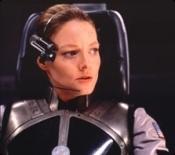
At the time of the movie's original DVD release, it was considered quite a loaded special edition. Our standards and expectations for such things are much higher now, of course. Even so, the content here is generally informative and interesting, which is more than can be said for the EPK fluff that passes for bonus material on most discs these days.
The Blu-ray carries over all of the important features from the DVD.
- Audio Commentary by Jodie Foster – The actress admits from the start that she's not particularly interested in visual effects. Her attraction to the project was the character's journey. In this low-key commentary, she shares a lot of anecdotes about the production, jokes about the difficulty of learning technobabble dialogue, and discusses the movie's themes.
- Audio Commentary by Robert Zemeckis and Steve Starkey – In contrast to Foster's track, the movie's director and producer are very excited about working with visual effects, which they point out as much as they can. They also talk about their desire to make the movie as scientifically accurate as they could, the casting process, and the practical logistics of making a big-budget sci-fi movie.
- Audio Commentary by Ken Ralston and Stephen Rosenbaum – Whatever technical details the second track forgot to cover are surely captured by the film's VFX supervisors. They explain the process of designing the opening shot, working with science advisors for as much astronomical realism as possible, and working with a demanding director like Zemeckis.
- The Making of the Opening Shot (SD, 20 min.) – Further elaboration from Ralston and Rosenbaum about how the dazzling opening was built. We get a look at real space images from the Hubble telescope that were used as much as possible, and many early animatics and compositing passes. The men also talk about how much '2001: A Space Odyssey' inspired their work, and how much of the imagery seen in the second half of the shot is based on theoretical science.
- The Making of the NASA Machine Destruction (SD, 6 min.) – A look at the way the many layers of imagery were constructed into the final effect.
- The Making of the Harrier Landing (SD, 9 min.) – How footage of a freighter ship on a sunny day was manipulated to become an aircraft carrier in the middle of a typhoon.
- The High-Speed Compositing Reel (SD, 6 min.) – Demonstrations of how the VFX compositing process works.
- Machine Fly-By (SD, 2 min.) – A different VFX artist presents 3-D animatics of the device.
- Hadden's Plane (SD, .5 min.) – More VFX material.
- NASA Control Room (SD, .5 min.) – And more.
- Trailers (SD, 4 min.) – Two suspenseful trailers.
HD Bonus Content: Any Exclusive Goodies in There?
The Blu-ray adds one new feature.
- Music-only Track – Alan Silvestri's treacly score is isolated in Dolby Digital 5.1 format. Since the score is only used minimally in the movie, that means that the track is mostly dead air.
The Cutting Room Floor: What Didn't Make the Blu-ray?
The DVD from 1997 also had some text production notes, and some cast & crew bios. For some reason, Warner didn't bother to port those over.
'Contact' is a terrific film that, in my opinion, redeems Robert Zemeckis from the artistic void of his previous, wretchedly overrated movie. The Blu-ray looks and sounds pretty great. The supplements may not be extensive, but are all interesting. This is a very solid catalog release in all respects. Recommended.
